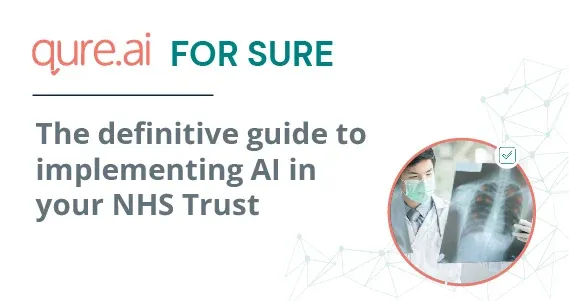Artificial Intelligence (AI) is redefining precision diagnostics and early detection of multiple diseases, including cancer, neuro-critical conditions, cardiovascular myopathy, and many more. In radiology, AI is used varyingly – its application is being experimented with across the healthcare dissemination pathway to identify the optimal implementation and deployment methodology.
Back
AI solutions, while being highly agile in screening and detection of abnormalities, can also be successfully deployed to optimize radiologists' workflows, facilitate quantitative radiology, and assist in the triage of critical cases. Finally, with the pandemic also weighing in on the current healthcare infrastructure, we can conclude that AI-enabled healthcare will eventually replace legacy infrastructure.
The Lancet reports that medical investigations leveraging computer-aided diagnostics (CAD) have shown excellent accuracy, sensitivity, and specificity for detecting minor radiographic abnormalities, potentially improving public health. It further states that AI could identify imaging pattern changes that are not readily amenable to human identification.
Earlier this year, the United Kingdom declared its goal of harnessing digital expertise and Artificial Intelligence (AI) to drive transformation within the NHS and social care. Similar adoption models are being discussed in hospitals and healthcare networks across the globe. At present, the workload on the radiology workforce is staggering, with a radiologist required to read a scan every 3-4 seconds. An AI-enabled workflow can alleviate this issue. Moreover, it can help bring down the intra and inter-reader variations. AI solutions can also help use radiology to detect numerous abnormalities early that can directly impact patient prognosis.
While the need for intelligent technology has been established, questions on how, what, and where, remain an open-ended discourse across the medical fraternity. As a result, not much historical data will come into play when an organization decides to implement AI within the system, which is where the collective knowledge of clinicians, radiologists, technologists, and AI solution providers come together. It is the premise of Qure.ai's eminent panel of experts on AI implementation including:
- Dr. Hugh Harvey, Hardian Health
- Dr. Amrita Kumar, Frimley Health NHS Foundation Trust
- Emma Hughes, NHS England and NHS Improvement
- Dr. Garry Pettet, Medica Reporting Ltd
- Matthew Watt, NHS Transformation Directorate
Step # 1: Identify and isolating the current bottlenecks
It can vary across the set-up of your organization, access to domain experts, and the use case you have identified. For example, at a teaching hospital, AI-enabled data mining may not be a priority as much as resolving the resource crunch and workforce planning. Whereas if you belong to academia, then this becomes your priority. A significant step in seamless implementation is to assemble the right team to implement the project and see to it – end to end. Deploying AI is not a pet project but a large-scale deployment that should integrate with your long-term goal. Getting all the stakeholders, including data governance, IT services, and the chief executive members, on the same page will help in the long run.
Step #2: Identify the right AI vendor for you
With multiple vendors available for similar solutions, industry-approved, clinically validated products should be your go-to option. Though AI is now being sold as a pattern recognition solution, building trust for the technology within the workforce should be your priority to enable them to rely on it as needed. Deploying AI for triage and acting as quality assurance is an excellent place to start. Check their peer-reviewed data and the status of their CE/FDA clearance. Lastly, run a pilot and get your success metrics clearly defined before any deployment. Any implementation is gauged as a success when well-defined success criteria are in place. Having a clear end goal – lives saved, time saved and/or money saved, needs to be obvious to understand the ROI of the solution.
Step #3: Evaluate if the solution solves for your business use case
If you are a teleradiology company looking for AI solutions, a whole new set of questions arises. While most points discussed above, hold true for a teleradiology context as well, like data privacy and FDA/CE clearance, and the host of peer-reviewed data to back an AI solution's precision and read accuracy, a teleradiology company will face more challenges when it comes to integrating the solution across their deployed sites. Unlike a hospital, where the deployment is singular, a teleradiology company will require a customized integration plan for every client site. The challenge heightens if they have multiple PACS vendors in place. When choosing a vendor, they will depend on the vendor's training data's transparency, integration agility, and customizable solutions and markers.
Step #4: Check for Regulatory Compliance
Experts have weighed in on the need for a single AI database. While the European market is getting ready to publish EUDAMED, the already available ECLAIR guidelines for choosing your AI partner will be the right place to start if you identify and deploy an AI solution in the EU region. While CE/FDA clearances are non-negotiable, it is equally vital that you understand the premise of these certifications.
Every AI solution that is CE/FDA cleared has an intended use statement and instructions to use a manual that is regulatory approved. While the vendor may have more to claim than what is present in these documents, you must do the due diligence to see if your problem statement matches your chosen partner's CE/FDA-marked intended use. Similarly, it is essential to see how compatible the chosen AI solution is with your data. Identifying the pre-determined biases and margins of error of a particular solution concerning your clinical data before deployment will help bring down false-positive rates and AI biases. Most vendors have ample documentation citing the same. Looking through their categorization of the solution's training database will also give you a clearer picture of what to modify when it comes to deployment.
